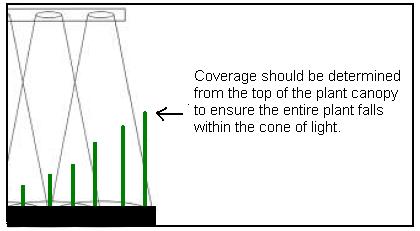What does it mean when a light has a “wide beam spread” or “narrow angle of light dispersion”? These are terms associated with LED grow lighting. The concept should be well understood if you are gardening under LEDs. Both phrases have to do with the angle at which light leaves an LED array. This angle determines both the intensity and coverage area of LEDs.

Using traditional glass bulb lighting, light is emitted in all directions. Therefore, when we turn on a light bulb in our home- the entire room lights up and not just the area beneath the bulb. When using these bulbs to grow plants, an external reflector is used to direct more of the light toward the intended grow area. Even with this reflector, turning on the bulb will scatter light throughout the room because it is reflecting from all angles within the external reflector. When we judge coverage on a light source such as HPS, a 4′ x 4′ recommendation would suggest that this is the area that will receive the most light.
LEDs work differently. Each individual LED is fitted with a built-in reflector designed to help the light shine only where it is directed. To understand angles of light dispersion simply picture the nozzle on your garden hose. A wide angle of dispersion causes a gentle misting over a large area, while a narrow angle of dispersion causes a concentrated jet stream hitting a small area. The same amount of water comes through the hose on either setting- the adjustment just dictates how much area the water will cover. Either the whole plot receives a sip of water or one plant gets blasted with the jet stream. Most indoor gardeners find there is a setting between these two extremes which best serves their purpose.
In LED terms, we can take two LED arrays that are identical in light output and give one a 180-degree beam spread and one a 14-degree beam spread. The LED array with the 180-degree beam spread is going to cover a much larger area but, the light is diluted through the whole 180 degrees; giving your plants a “misting” of light. The 14-degree beam spread LED array is going to provide a powerful stream of light, but the light would be limited to a very small area directly beneath the LEDs. The ideal is designed around the middle ground. Beams spread between 45 degrees and 33 degrees are narrow enough to provide a concentrated source of light, but wide enough to cover an area much larger than the unit itself, allowing sunlight through to the plant canopy in applications where sunlight is available.
Because the light from an LED array is emitted at a specific angle the result is a cone shaped light emission. The cone of light gets larger and larger the further from the source. Only plants that are within the cone will receive light. Because of this focus the expected height and width of the full-grown plant should be taken into consideration. As plants get larger, only portions that fall within the light cone will grow properly.
Angela Lundmark enjoys gardening outdoors and indoors and freelance writer.
Related Articles & Free Email Newsletter
A Beginners Guide to Grow Lights
Grow Lights can Work Together with LED/HPS/MH Hybrids




Comment here